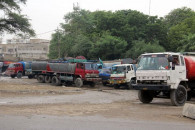HPV Vaccination: a pragmatic strategy to prevent cervical cancer
Raising awareness about Human Papillomavirus vaccine for cervical cancer prevention is the need of the hour

Merriam-Webster’s 2021 word of the year was ‘vaccine’, which saw an increase of greater than 600% in lookups since last year. Vaccines are a well-known tool for combating life-threatening childhood infectious illnesses, and today represent a possibility of a return to normalcy and the pre-pandemic life. What is less known and less advocated in our part of the world is the value of vaccines in preventing non-communicable diseases, such as cancer. Raising awareness about these vaccines, particularly the Human Papillomavirus (HPV) vaccine for cervical cancer prevention, is the need of the hour.
According to the WHO, cervical cancer kills a woman every two minutes and contributes to 7.5% of cancer-related deaths in females globally. In Pakistan, cervical cancer is the third most common cancer and the fifth leading cause of cancer-related deaths in females.
WHO has proposed that all countries reach an incidence rate of less than 4 cases per 100,000 women by 2030 to effectively eliminate cervical cancer as a public health concern. Since almost all cervical cancer cases are linked to an infection with the Human Papillomavirus (HPV), HPV vaccination is the globally recommended prevention strategy. Pakistan can achieve the WHO target by including the HPV vaccine in the Expanded Programme on Immunization (EPI) for girls and vaccinating all females between the ages of 9 and 14 years.
Unfortunately, in Pakistan, there is limited awareness of the HPV vaccine as a prevention tool, resulting in low vaccination rates. Of the many varieties of HPV, types 16 and 18 are responsible for 88% of cervical cancer cases in Pakistan. Currently, four HPV vaccines have been pre-qualified by WHO, all of which protect against the 16 and 18 strains. The vaccine does not contain the virus; instead, it has virus-like particles that cause the body to produce antibodies. Data from 26 randomized control trials (including more than 70,000 women) demonstrates that the HPV vaccine is safe, and significantly decreases the risk of cervical disease in young women. There is also no need for a booster, as studies following vaccinated individuals for more than ten years show that it offers long-lasting protection against HPV-related diseases.
Many countries have made headway towards the large-scale implementation of vaccination programmes. Slovenia exhibited a sharp decline in cervical cancer cases through its robust national vaccination and screening programmes. Their highest incidence rate was 27 per 100,000 women in the 1960s, which dropped to 6 per 100,000 women in 2019. The United Kingdom implemented its HPV vaccination programme for teenage girls in 2008 and achieved promising results.
The vaccine reduced cervical cancer incidence rate by 34% in individuals who received it at 16-18 years, by 62% in those aged 14-16 years, and by 90% in those aged 12-13 years. On the other side of the globe, Australia became the first country to establish a fully funded HPV vaccination programme in 2007. From 2013, boys were also included in their school-based vaccination programme as research surfaced showing that persistent HPV infection can cause some forms of cancer in men. The nation set a precedent by providing equitable and free access to the HPV vaccine allowing more individuals to gain protection from HPV-associated illnesses. Unsurprisingly, Australia is set to become the first country to eliminate cervical cancer as a public health concern by 2035. These examples offer concrete evidence that vaccination, with a focus on equity, is central to our fight against cervical cancer.
Claiming the lives of more than 3,000 Pakistani women annually, cervical cancer is a serious public health issue that demands our immediate attention. We must work towards increasing the general public’s awareness about HPV and cervical cancer prevention through educational campaigns and community mobilization. The challenges associated with the HPV vaccine, such as the high cost of the vaccine, lack of requisite knowledge about its safety, and low acceptability in the general population, also require pragmatic solutions. Some of these problems can be tackled with support from Gavi, the Vaccine Alliance, which assists eligible countries in running their national routine HPV vaccination programmes.
WHO recommends two doses of the HPV vaccine; however, recent studies show that a single dose also protects against HPV. Single-dose HPV vaccine programmes, if implemented, could be cost-effective, logistically efficient, and may lead to better compliance. Lastly, gynecologists, family physicians, pediatricians, and other healthcare professionals should also play their part in educating the public about the benefits and safety of the vaccine. Since parents of young girls are the primary health decision-makers for their children, their fears need to be compassionately and patiently allayed, so they are motivated to get their daughters vaccinated.
Through a committed national strategy, we should ensure that every woman has access to the prevention, screening, and treatment services needed to fight cervical cancer. We must remember that cervical cancer is highly preventable, and it would be a grave public health failure if our women continue to die from it.
The author is Maheen Zakaria, who is a Medical Student at Aga Khan University, Karachi
The co-author is Dr Afshan Anwar Ali Manji, who is a Research Associate in The Department of Medicine, Aga Khan University, Karachi
The second co-author is Dr Uzma Shamsi, who is an Assistant Professor in The Department of Community Health Sciences, Aga Khan University, Karachi



















COMMENTS
Comments are moderated and generally will be posted if they are on-topic and not abusive.
For more information, please see our Comments FAQ